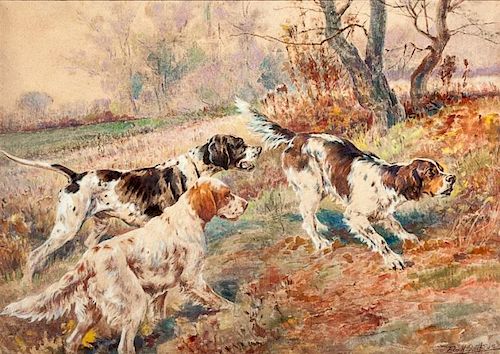Edmund H. Osthaus (1858-1928)
About Seller
20 Winter Street
Pembroke, MA 02359
United States
Founded in 2005, Copley Fine Art Auctions is a boutique auction house specializing in antique decoys and American, sporting, and wildlife paintings. Over the course of the last two decades, the firm has set auction records for not only individual decoy makers, but also entire carving regions. Copley...Read more
Two ways to bid:
- Leave a max absentee bid and the platform will bid on your behalf up to your maximum bid during the live auction.
- Bid live during the auction and your bids will be submitted real-time to the auctioneer.
Bid Increments
| Price | Bid Increment |
|---|---|
| $0 | $50 |
| $1,000 | $100 |
| $2,500 | $250 |
| $5,000 | $500 |
| $10,000 | $1,000 |
| $25,000 | $2,500 |
| $50,000 | $5,000 |
About Auction
Jul 25, 2015 - Jul 26, 2015
Copley Fine Art Auctions cinnie@copleyart.com
- Lot Description
Three Setters
signed "Edm. H. Osthaus" lower right
watercolor, 19 by 27 in.Edmund Henry Osthaus was born in Hildesheim, Germany, in 1858, the son of a prosperous farmer who subsequently immigrated to Toledo, Ohio. Osthaus studied at the Royal Academy of the Arts in Dusseldorf from 1874 to 1882 with Andreas Muller, Peter Jansen, E. von Gebhardt, Ernst Deger, and wildlife and landscape painter Christian Kroner. In 1883, after studying painting for six years, Edmund Osthaus became an instructor at the Toledo Academy of Fine Arts. He served as the director from 1886-1893, refining his painting technique and pursuing his passions: hunting and fishing.
In 1893 Osthaus dedicated his full attention to painting, shooting, and field trials. He was a charter member of the National Field Trial Association established in Newton, North Carolina, in 1895. Edmund Osthaus followed field trials from the fall prairie chicken trials in Canada to the important quail trials in the South in mid-winter, judging, sketching, and sometimes entering his dogs. He was a handsome, powerfully built man," and his artistic talent combined with his love of dogs enabled him to capture the essence of the focused working dog while depicting them in precise anatomical detail.
"Any painter who paints for shooting men had better be a shooting man himself, for no one is more jealously critical of detail than the man who knows guns and dogs and game... Edmund Osthaus, who trained and shot over his own setters and pointers, transformed oil paint into dog flesh quivering under the stress of a point."
Provenance: Davison B. Hawthorne Collection
Literature: Kay and George Evans, "Dogs that Live Forever," Field & Stream, Vol. LXXV, No. 2, June 1970, pp. 234-240.
Condition
Provided upon request.
- Shipping Info
-
Shipping info
Copley Fine Art Auctions does not handle the shipping of any items. Shipping is the sole responsibility of the buyer. Once your payment has cleared, and we have received your authorized shipping release form items may be released for shipment. Copley Fine Art Auctions, LLC shall have no liability for any loss or damage to such items. Buyers should allow up to four weeks for shipment.PLEASE BE AWARE THAT INTERNET BIDDERS MAY NOT PICK UP THEIR ITEMS AT THE SALE SITE. ITEMS CAN BE PICKED UP BY APPOINTMENT OR SHIPPED STARTING FIVE DAYS AFTER THE CONCLUSION OF THE SALE
-
- Buyer's Premium



 EUR
EUR CAD
CAD AUD
AUD GBP
GBP MXN
MXN HKD
HKD CNY
CNY MYR
MYR SEK
SEK SGD
SGD CHF
CHF THB
THB












